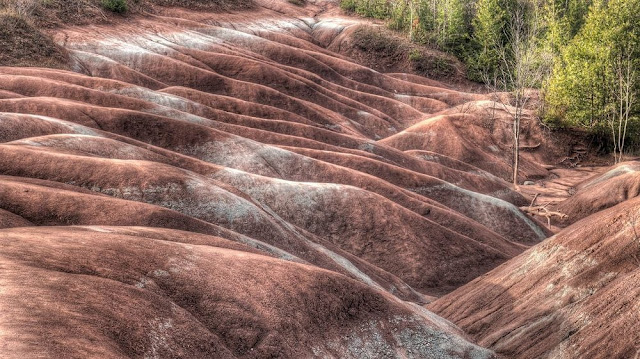The Cheltenham Badlands is an area in Caledon, Canada, consisting of bare, windswept red hills and gullies displaying spectacular colors th...
The Cheltenham Badlands is an area in Caledon, Canada, consisting of bare, windswept red hills and gullies displaying spectacular colors that alternates from bright clays to red scoria, streaked with narrow greenish bands. Unlike natural causes such as erosion by wind and water, Cheltenham Badlands was caused by human intervention.
The impermeable nature of the shale causes water to run over it, taking away sediments, and allowing the water to cut into the shale. The constant action of erosion has not only crafted the shape of the badlands, but also has helped paint it's unique color. The red color is caused by the oxidization of iron when it gets exposed to oxygen and water. The faint green streaks is due to ground water percolation changing the red iron oxide into green iron oxide.
The attractive landscape has drawn people from all around Canada, who walk on the formation, putting further stress on the fragile landscape. In 2015, the badlands site was fenced off and closed to the public.
The impressive landscape was originally formed at the base of an ancient sea over 400 million years ago. All these years, the reddish Queenston Shale was covered by a layer of limestone, sandstone, sand and gravel, until the early 1900s, when poor farming practice and overgrazing caused the shale to get exposed.
This area was once a fertile region used by the Native tribes and original Canadian settlers. It was used partly as pasture, as an apple orchard, and to grow crops like wheat, potatoes, and peas. The land was later used to graze cattle, and the heavy use caused the soil to deplete, diminishing vegetation. Eventually, erosion laid bare the shale underneath.
The impermeable nature of the shale causes water to run over it, taking away sediments, and allowing the water to cut into the shale. The constant action of erosion has not only crafted the shape of the badlands, but also has helped paint it's unique color. The red color is caused by the oxidization of iron when it gets exposed to oxygen and water. The faint green streaks is due to ground water percolation changing the red iron oxide into green iron oxide.
The attractive landscape has drawn people from all around Canada, who walk on the formation, putting further stress on the fragile landscape. In 2015, the badlands site was fenced off and closed to the public.






No comments